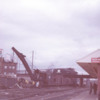Back when it was Pennsy...say 1940...How many daily passenger trains used the NEC? Also, since it was a freight main then as well...where did Conrail shift all the North-South freight traffic to? Did Penn Central run a bunch of freight on the NEC?
Mike
It is stunning to think of the geographic and economic position of the Pennsylvania Railroad in 1940. The principal cities on the PRRs north-south main line, NYC, Philadelphia, Baltimore and Washington were the 1st, 3rd, 7th and 11th largest in the nation that year. And, as we all know, the Pennsy main line to the west tied in with the north-south main line at Philadelphia to reach Chicago, Detroit, Cleveland, St. Louis, and Pittsburgh. Those were the 2nd, 4th, 6th, 8th and 10th largest cities in America at the time. Of the top ten cities only L.A. and Boston weren't served directly by the PRR. New York was the nation's largest port and Baltimore was also in the top 10.
The volume of passenger and mail traffic between those cities every day was staggering. The volume of freight was huge as well. Imagine watching the airliners, trucks and buses traveling between those cities today if they all crossed at Philadelphia! That volume, combined with the communication technology of the time, is why the PRR had four track main lines north and south as well as to the west.
Unfortunately, like some of its stock holders, the PRR took wealth as a birthright and was slow in responding to changing technology, a changing economy and a changing society. Stifling government regulation didn't help, especially when trying to catch up with those in the transportation market that had moved ahead of the Standard of the World.






